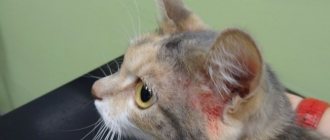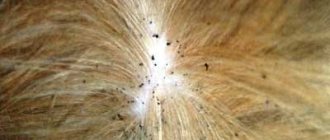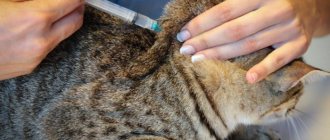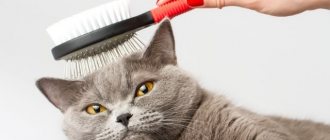11/13/2021 92,465 Diseases and treatment of cats
Author: Olga
When a cat itches or diligently licks itself, this is a completely normal and natural phenomenon. However, animal owners should be wary of their too frequent manifestation, which is accompanied by anxiety and irritability. In this case, often the animal already needs help. Remember that itching is not a disease, but its first symptom, so this manifestation cannot be ignored.
[Hide]
Main causes of itching
All causes of itching in cats are divided into several groups.
Ectoparasites
This group includes subcutaneous and cutaneous mites, as well as other blood-sucking parasites. When they appear, dandruff and other flaking appear, hair falls out, and the cat itches until it bleeds.
Severe itching is characteristic of the following diseases:
- Otodectosis. The animal often scratches its ears, face, and shakes its head. As a result of the activity of ear mites, black deposits are noticeable in the shells.
- Sarcoptic mange (pruritic scabies). The cat scratches its neck. If left untreated, the itching moves to the back. Associated symptoms are hair loss at the base of the tail and the appearance of crusts over the body.
- Notoedrosis. The muzzle, back of the head, and brow ridges are susceptible to itching. The animal itches until it bleeds. As a result, the skin becomes rough and thick.
- Cheyletiellosis (wandering scabies). The main symptoms are that the cat itches all the time, and “live dandruff” is noticeable in the tail area. A detailed examination will show that it is not dandruff, but gray skin mites.
- Lice, lice, mites and flea dermatitis. In most cases, fleas and the saliva they secrete are to blame. When infected with them, the cat constantly itches and licks itself. Because of this, hair falls out and bald patches appear.
Allergies
With a food allergy, the cat actively scratches its face and ears, licks and bites its paws. This happens when there is a sudden change in food or the introduction of new foods into the diet. Most often, allergies are caused by insect bites: mosquitoes, wasps, bees, ants.
Interesting! Food allergies in cats often occur when there is a sudden change in food.
Some cat breeds are prone to seasonal allergies. Itching is caused by pollen, house dust, and certain plants. Contact with chemicals and household products also leads to itching and irritation.
Important! Atopic dermatitis cannot be cured. The doctor only prescribes maintenance medications. They reduce symptoms and are given to the animal for the rest of its life.
Contact allergies are a rare type. It occurs when an allergen comes into contact with an animal's skin. As a rule, this is the area of the abdomen and chest. If this type of reaction is suspected, allergy tests are performed.
Skin infections
If your cat is itching but there are no fleas, skin infections may be the cause. They most often join the primary problem. As a result of the activity of bacteria, eczema and weeping wounds develop on the pet's skin. The cat licks them, which causes open wounds.
The development of a fungal disease is indicated by bald areas of the body, peeling and changes in pigmentation. Dermatophytosis manifests itself in individual foci or their connection throughout the body.
Dermatophytosis is characterized by inflammation of the skin in places where it is damaged. These can be insect bites, allergic and neurological wounds. There is redness, swelling or swelling of a certain area on the cat's skin. If an animal scratches its skin vigorously, the temperature of that part of the body rises.
Dry skin
Due to a lack of vitamins A and E in the body, as well as when choosing poor-quality hygiene products, the skin dries out. This process is accompanied by severe itching. First, the cat itches on the sides and back. Then dandruff appears, the skin dries out and cracks in places. The coat does not fall out, but noticeably becomes dull and loses its healthy appearance.
Autoimmune pathologies
Autoimmune pathologies are quite difficult to diagnose and treat. They are characterized by a violation of the body's immune system. As a result, protective cells perceive their own cells and tissues as foreign and attack them.
Important! Discoid lupus erythematosus occurs most often in dogs and is extremely rare in cats.
Such pathological processes are characteristic of diseases:
- Discoid lupus erythematosus. It is characterized by the sudden appearance of wounds and other injuries on the body. In this case, antimicrobial drugs do not give results. Immunosuppressants and glucocorticoids are effective in suppressing this process.
- Jacobs ulcer. This is truly a cat disease. It is characterized by the appearance of a sore on the upper lip of the animal. At first it is a small bubble. Then it turns into an ulcer. If left untreated, teeth and gums become exposed. Antibiotics and wound-healing drugs do not give results.
- Pemphigus foliaceus. The cat itches to the point of sores in the face area. Infections and bacteria often penetrate into scratching areas. This leads to tissue inflammation and the appearance of crusts.
Psychogenic factors
Cats do not tolerate stressful situations well. And at the slightest nervous tension there is a risk of psychogenic itching. The animal begins to chew its tail or itch. In this way the pet calms itself. Soon a dependence on this process arises.
Interesting! Diagnosing psychogenic itch is a complex process. It is determined by excluding other possible causes.
Other reasons
When there are hormonal imbalances, the cat constantly itches and licks. These symptoms are characteristic of the following pathologies.
- Thyroid gland dysfunction. Additionally, hair loss, dullness, dandruff and itching are noted.
- Diabetes. With this disease, cats experience partial hair loss, dullness, dryness, and seborrhea.
- Cushing's syndrome. Improper functioning of the adrenal cortex leads to loss of skin elasticity. Comedones appear on the back and sides.
Cats often itch due to ear infections. Itchy places are the ears, neck and head. With otitis media, discharge containing pus or wax appears from the ears. Marginal seborrhea affects only the tips of the ears. Outwardly, they lose their previous shape, look ugly and unkempt. A bacterial infection is often associated.
Interesting! The most common sign of ear disease is a cat constantly shaking its head.
In the tail area, cats will often wash and lick themselves when the paraanal glands are blocked. The animal can sit and move its butt along the floor. This problem occurs due to poor nutrition. Similar symptoms are characteristic of helminth infection. Determining the exact diagnosis is carried out by exclusion.
Inflammatory processes that cause cats to itch
An obvious pathological factor that provokes constant itching of the skin in an animal is an active inflammatory process. It can be both local and systemic. The most well-known diseases in cats accompanied by an inflammatory process:
- Otitis. If this disease is present, the cat constantly scratches its ears and is very irritable because it suffers from severe pain. The solution to the problem will be the use of drugs that reduce the intensity of the inflammatory process in the designated location;
- Pyoderma. Pyoderma in animals is manifested by purulent inflammation of the skin provoked by coccal bacteria. The cat's epithelium is deeply affected and cannot be treated with local remedies: antibacterial therapy is required under the mandatory supervision of a veterinarian;
- Secondary bacterial infections. They occur after insufficient aseptic treatment of wounds, cuts, and surgical sutures. Treated with broad spectrum antibiotics.
What should the owner do if the cat is itching and licking?
Owners are usually alarmed if a domestic cat frequently licks and scratches itself. And such problems must be resolved immediately. Otherwise, the animal’s behavior will lead to the appearance of deep wounds and scratching. And they are dangerous due to the penetration of pathogenic fungi and bacteria.
There are many reasons for such symptoms. This means that looking for them on your own is pointless and even dangerous. In order not to waste time, the best solution is to contact a veterinarian.
Important! The maximum allowable help from the owners is to treat the pet for worms and fleas. If the animal continues to itch all the time, you need to contact a veterinarian.
Psychogenic factors
Cat owners underestimate the potential psychogenic causes of itching in an animal. The latter appear during periods of severe stress, for example, in the absence of the possibility of mating. In this case, the pet may not only constantly itch, but also mark its territory, behave aggressively, refuse to eat food, and tear furniture with its claws.
There are several ways to solve the problem:
- Organization of mating;
- Castration of an animal;
- Using special sedatives for cats.
Diagnosis of itching in the clinic
There is a certain diagnostic algorithm if a cat’s skin begins to peel, hair falls out, and other dermatological symptoms are observed - it itches, licks:
- Anamnesis collection. The owner provides information about the cat’s breed and age, nutritional habits, and preventive treatments.
- Itching analysis. The doctor determines whether the skin is itchy all over the body or in certain places. Equally important is the frequency and frequency of symptoms.
- Scrapings from places where the kitten itches most often. It is carried out to determine bacterial and fungal infections.
- Analysis for the presence of skin and subcutaneous parasites.
- Examination of the ears for otitis media, ear mites or seborrhea.
- Elimination diet to identify allergens.
- Exclusion of atopic and other types of allergies in cats.
After the diagnosis is made, treatment for the cause itself is prescribed. Elimination of itching is a secondary focus, so the cat may continue to itch during treatment.
How can a veterinarian help?
First of all, you need to figure out why the cat sheds so much. And only after that solve the problem.
It is not recommended to try to determine the cause on your own.
This should be done by a veterinarian after a thorough examination of the cat and some research (including laboratory blood tests).
If the veterinarian determines that it is an allergy, then antihistamines will be prescribed, and you will have to identify and remove the allergen.
Add vitamins to the diet, but only do this after your veterinarian has told you exactly which vitamins and minerals your pet is lacking.
Wool requires fatty acids (omega-3 and others), thanks to which the fur will shine, sparkle, and become thicker.
Carry out deworming. And don’t forget about it, make a schedule and stick to it.
Get rid of fleas and other skin parasites.
Yes, they may not be to blame for the fact that the cat sheds, but prevention has never done any harm (if in reasonable quantities, of course).
Therapy
You cannot treat a cat that is constantly licking and itching on your own. The diagnostics carried out reveal the true reason for this behavior. And based on it, the veterinarian prescribes a certain set of drugs. Therapy is divided into two groups:
- Etiotropic. The action is aimed at eliminating the cause that causes itching. The most effective option.
- Symptomatic. Treatment is aimed at controlling symptoms, particularly itching. It is temporary. Ineffective.
Important! The owner can help the animal if he follows all the veterinarian’s instructions. Stopping or adding medications on your own can cause serious harm to your cat.
Veterinarian advice
Despite the risks of being outside, the cat needs fresh air, so you should not limit its freedom. Since infections and parasites are transmitted through hands or from other animals, preventative treatment against parasites should be carried out regularly.
Veterinarian advice:
- The animal must be kept clean.
- A good immune system will protect your cat from any infection. The key to health is proper and balanced nutrition.
- To prevent allergies, you should not include smoked and salty foods in your diet. Sweets are also prohibited.
- A change of owner or a sharp change in attitude towards a pet leads to stress and illness. A pet needs to be loved, cared for, and given enough attention.
The cat licks and itches, but there are no fleas
A signal about the development of the disease can be constant licking of fur, scratching and excessive attentiveness to one’s appearance. Often the cat owner thinks that the pet has fleas, but when examining the fur, it is clear that this is not the reason.
Possible causes of itching:
- allergy;
- fungal diseases;
- hormonal diseases;
- hypo- and vitamin deficiencies;
- change of diet.
Be sure to read:
A cat's hair is falling out: reasons, what to do during shedding, treatment of baldness, approved medications
The cat licks itself vigorously and goes bald
Sometimes itching occurs for psychogenic reasons. Increased licking and scratching occurs when the animal is stressed. This is often observed when an individual requires mating. Taking sedatives will help calm your pet.
Cat licks after sterilization
Cats always try to lick wounds, sores and other skin lesions. After sterilization, a seam remains, which itches and itch, so the animal scratches and licks it. To prevent bleeding or other serious complications, a surgical collar is placed on the cat.
What to do if your cat is constantly licking
It can be difficult to diagnose why an animal constantly licks itself. First, the cat is checked for fleas, then it is analyzed whether the diet or care products have changed.
With a skin disease, the animal often shakes its head and licks itself until it bleeds. Only a doctor can diagnose the disease, so the pet must be taken to the clinic immediately. Based on the scrapings taken, they will be able to identify mites or fungal spores.
Prevention measures
The appearance of itching in cats is provoked by a large number of factors. Some preventive measures can minimize most of them:
- Regularly carry out anthelmintic treatment. Preventing worms 3-4 times a year will protect the animal and people who come into contact with it. For the same reason, raw meat, fish and other animal products are excluded from the cat’s diet.
- Minimize stressful situations for the animal.
- Examine the cat for wounds and abrasions after visiting the street. And if they are found, disinfect them.
- If you need to change food, do it gradually.
- Minimize contact with other animals. It is through contact that infection with skin and subcutaneous parasites occurs.
- Wash your cat's litter box regularly and disinfect it.
If your cat itches until it hurts, then this is a reason to contact a veterinarian. Timely treatment of the animal will relieve it from annoying itching and the risk of complications.










